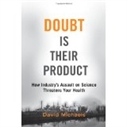Doubt is their product: how industry's assault on science threatens your health
"It started with Big Tobacco. In the 1950s, when epidemiologists showed that lung cancer was killing smokers, the cigarette companies launched a sophisticated public relations campaign to raise doubts about the increasingly definitive scientific evidence. The tobacco industry recognized that if...
| Main Author: | |
|---|---|
| Institution: | ETUI-European Trade Union Institute |
| Format: | TEXT |
| Language: | English |
| Published: |
New York
2008
Oxford University Press |
| Subjects: | |
| Online Access: | https://www.labourline.org/KENTIKA-19291977124910191599-Doubt-is-their-product-how-ind.htm |
| Summary: | "It started with Big Tobacco. In the 1950s, when epidemiologists showed that lung cancer was killing smokers, the cigarette companies launched a sophisticated public relations campaign to raise doubts about the increasingly definitive scientific evidence. The tobacco industry recognized that if they could limit the debate to whether the science was accurate, they could avoid the obvious policy discussion: how to stop people from buying their deadly product.
The scientists and public relations experts who manufactured uncertainty for Big Tobacco saw that their strategy worked - do it well and you immobilize government regulators. Tobacco's success has spawned a multimillion dollar industry. Now the strategy is deployed to defend drugs like Vioxx, the pain killer that has caused 100,000 heart attacks; food additives like artificial butter flavor, linked to popcorn lung disease; and scores of pesticides and toxic industrial chemicals like asbestos, lead, and benzene. When researchers discovered that taking aspirin dramatically increased children's risk for developing the often-fatal disease Reye's syndrome, manufacturers claimed that more proof was needed and delayed warnings on aspirin bottles for two years. Hundreds of children died needlessly. The oil and coal companies use this same strategy to question the existence of global warming. ..." |
|---|---|
| Physical Description: | 372 p. Paper |

